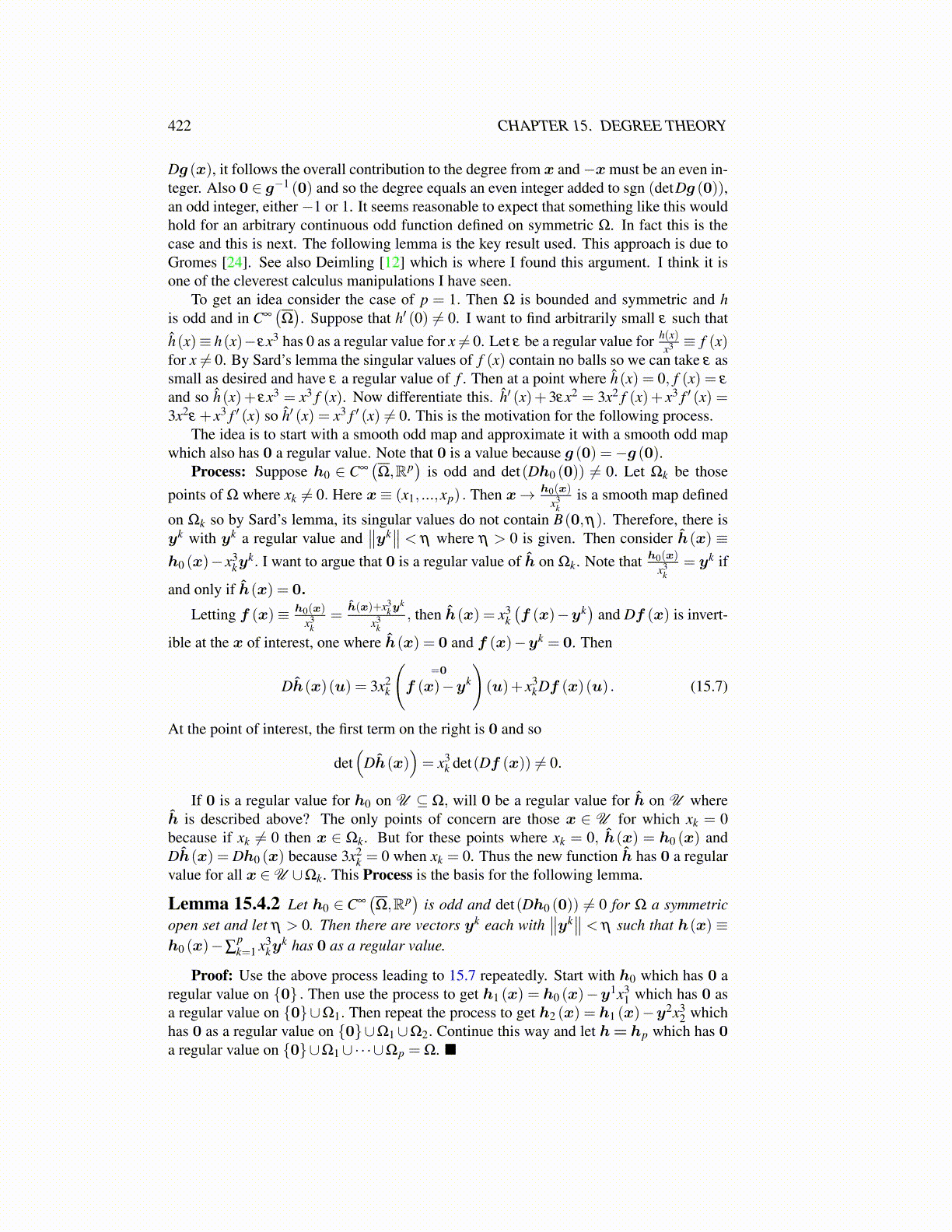
422 CHAPTER 15. DEGREE THEORY
Dg (x), it follows the overall contribution to the degree from x and−xmust be an even in-teger. Also 0 ∈ g−1 (0) and so the degree equals an even integer added to sgn (detDg (0)),an odd integer, either−1 or 1. It seems reasonable to expect that something like this wouldhold for an arbitrary continuous odd function defined on symmetric Ω. In fact this is thecase and this is next. The following lemma is the key result used. This approach is due toGromes [24]. See also Deimling [12] which is where I found this argument. I think it isone of the cleverest calculus manipulations I have seen.
To get an idea consider the case of p = 1. Then Ω is bounded and symmetric and his odd and in C∞
(Ω). Suppose that h′ (0) ̸= 0. I want to find arbitrarily small ε such that
ĥ(x)≡ h(x)−εx3 has 0 as a regular value for x ̸= 0. Let ε be a regular value for h(x)x3 ≡ f (x)
for x ̸= 0. By Sard’s lemma the singular values of f (x) contain no balls so we can take ε assmall as desired and have ε a regular value of f . Then at a point where ĥ(x) = 0, f (x) = ε
and so ĥ(x)+ εx3 = x3 f (x). Now differentiate this. ĥ′ (x)+ 3εx2 = 3x2 f (x)+ x3 f ′ (x) =3x2ε + x3 f ′ (x) so ĥ′ (x) = x3 f ′ (x) ̸= 0. This is the motivation for the following process.
The idea is to start with a smooth odd map and approximate it with a smooth odd mapwhich also has 0 a regular value. Note that 0 is a value because g (0) =−g (0).
Process: Suppose h0 ∈ C∞(Ω,Rp
)is odd and det(Dh0 (0)) ̸= 0. Let Ωk be those
points of Ω where xk ̸= 0. Here x≡ (x1, ...,xp) . Then x→ h0(x)
x3k
is a smooth map defined
on Ωk so by Sard’s lemma, its singular values do not contain B(0,η). Therefore, there isyk with yk a regular value and
∥∥yk∥∥ < η where η > 0 is given. Then consider ĥ(x) ≡
h0 (x)− x3ky
k. I want to argue that 0 is a regular value of ĥ on Ωk. Note that h0(x)
x3k
= yk if
and only if ĥ(x) = 0.
Letting f (x)≡ h0(x)
x3k
=ĥ(x)+x3
kyk
x3k
, then ĥ(x) = x3k
(f (x)−yk
)and Df (x) is invert-
ible at the x of interest, one where ĥ(x) = 0 and f (x)−yk = 0. Then
Dĥ(x)(u) = 3x2k
(=0
f (x)−yk
)(u)+ x3
kDf (x)(u) . (15.7)
At the point of interest, the first term on the right is 0 and so
det(
Dĥ(x))= x3
k det(Df (x)) ̸= 0.
If 0 is a regular value for h0 on U ⊆ Ω, will 0 be a regular value for ĥ on U whereĥ is described above? The only points of concern are those x ∈ U for which xk = 0because if xk ̸= 0 then x ∈ Ωk. But for these points where xk = 0, ĥ(x) = h0 (x) andDĥ(x) = Dh0 (x) because 3x2
k = 0 when xk = 0. Thus the new function ĥ has 0 a regularvalue for all x ∈U ∪Ωk. This Process is the basis for the following lemma.
Lemma 15.4.2 Let h0 ∈ C∞(Ω,Rp
)is odd and det(Dh0 (0)) ̸= 0 for Ω a symmetric
open set and let η > 0. Then there are vectors yk each with∥∥yk∥∥ < η such that h(x) ≡
h0 (x)−∑pk=1 x3
kyk has 0 as a regular value.
Proof: Use the above process leading to 15.7 repeatedly. Start with h0 which has 0 aregular value on {0} . Then use the process to get h1 (x) = h0 (x)−y1x3
1 which has 0 asa regular value on {0}∪Ω1. Then repeat the process to get h2 (x) = h1 (x)−y2x3
2 whichhas 0 as a regular value on {0}∪Ω1∪Ω2. Continue this way and let h= hp which has 0a regular value on {0}∪Ω1∪·· ·∪Ωp = Ω. ■